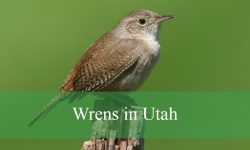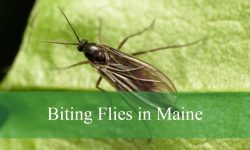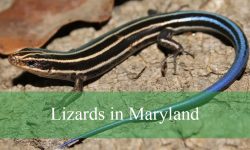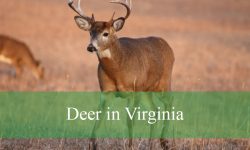Butterflies in Florida are some of the most colorful and fascinating insects found in the Sunshine State. Thanks to Florida’s warm climate and diverse environments, the state hosts a wide variety of butterfly species with unique patterns, colors, and behaviors. Exploring butterflies in Florida is a wonderful way to appreciate the natural beauty and rich wildlife of the region.
From the well-known Monarch to the rare Miami Blue, butterflies in Florida display an amazing array of shapes and vibrant colors. These insects brighten gardens, parks, and wild areas while playing an important role in pollination and supporting ecosystems. Learning to identify butterflies in Florida can enhance your outdoor experiences and deepen your connection to nature.
This article introduces 45 types of butterflies in Florida, complete with pictures and identification details. The guide is designed to help you recognize these beautiful creatures and understand their distinctive features. Get ready to discover the incredible diversity of butterflies in Florida and enjoy the vibrant life fluttering around you.
Different Types of Butterflies in Florida
Zebra Longwing (Heliconius charithonia)
![]()
The Zebra Longwing, Florida’s official state butterfly, is instantly recognizable by its elongated wings marked with bold black and pale yellow stripes. This elegant butterfly has a wingspan ranging from 2.8 to 3.9 inches and moves with a slow, graceful flight. Its body is slender, and it tends to glide more than it flaps, making it one of the most distinctive butterflies in the southeastern United States.
In Florida, Zebra Longwings are common throughout the year, especially in the southern and central regions. They are often seen fluttering in hardwood hammocks, subtropical thickets, gardens, and along forest edges. These butterflies are unique for their social behavior—they often roost communally at night in small groups, returning to the same perch day after day.
Unlike most butterflies that feed only on nectar, the Zebra Longwing also consumes pollen, which gives it added longevity and the ability to lay more eggs over time. The larvae feed primarily on passionflower vines (Passiflora species), which are abundant in Florida’s warm climate. Their long lifespan and social habits make them fascinating to both scientists and nature lovers alike.
Monarch (Danaus plexippus)
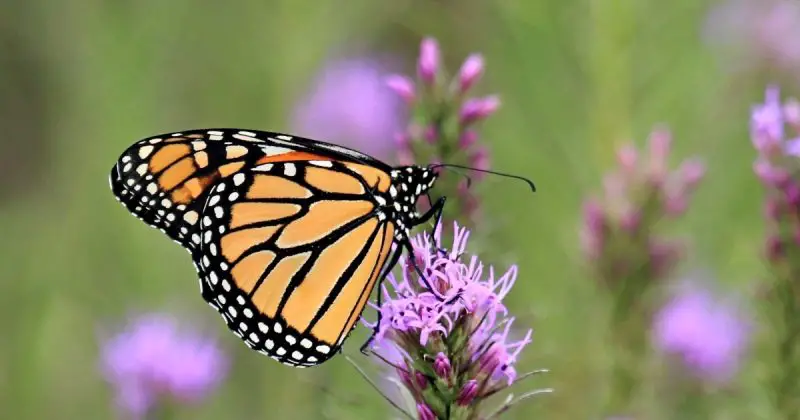
The Monarch butterfly is perhaps the most iconic butterfly in North America, known for its vivid orange wings with black veins and white-spotted edges. With a wingspan of 3.5 to 4 inches, this species is both large and visually striking. Males can be distinguished from females by the presence of black scent glands on their hind wings.
Monarchs are famous for their incredible long-distance migration. While most of the eastern population travels from Canada to central Mexico, a significant non-migratory population lives year-round in southern Florida, especially in the Keys and coastal regions. Florida also serves as a breeding and waystation point for migrants during their journey.
This species depends on milkweed (Asclepias spp.) as the sole host plant for its larvae. Monarch caterpillars ingest the plant’s toxic compounds, which render them unpalatable to predators. Adult Monarchs feed on nectar from a wide variety of flowers, making them common in butterfly gardens, meadows, and natural preserves throughout Florida.
Gulf Fritillary (Agraulis vanillae)
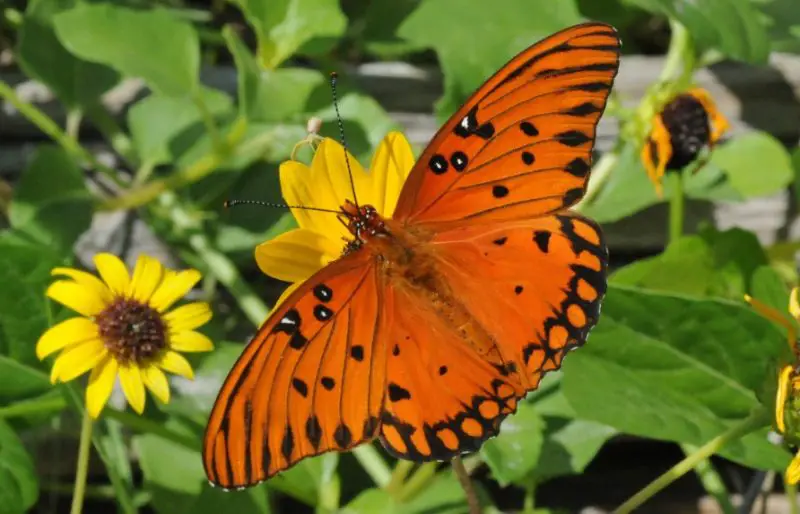
The Gulf Fritillary is a vibrant orange butterfly with black spots on the upper side of its wings and bright silver spots on the underside. With a wingspan of about 2.5 to 3.7 inches, it is often mistaken for the Monarch but can be easily identified by its unique wing shape and the shimmering silver markings beneath.
This species is widely distributed throughout Florida, especially in open sunny areas such as fields, gardens, roadsides, and coastal habitats. It is active year-round in southern Florida and is most abundant from late spring through fall in northern parts of the state. The adults are fast fliers and frequently visit lantana, zinnias, and other nectar-rich flowers.
Gulf Fritillary larvae feed exclusively on passionflower vines (Passiflora spp.), particularly Passiflora incarnata and Passiflora suberosa. The caterpillars are orange with black spines and are harmless despite their fierce appearance. The butterfly’s dependence on passionflowers makes it a common resident of Florida gardens that cultivate native plants.
White Peacock (Anartia jatrophae)

The White Peacock is a medium-sized butterfly with a wingspan of 2 to 2.5 inches and distinctive white wings adorned with brown and orange patterns, including two prominent eyespots on each wing. The delicate scalloped edges of its wings and soft coloration make it a favorite among butterfly watchers.
This butterfly is especially common in the wetlands and open grassy areas of central and southern Florida. You can often find it near canals, ponds, drainage ditches, and marshy fields. It prefers sunny, moist environments where its host plants, such as water hyssop (Bacopa monnieri) and frogfruit (Phyla nodiflora), are abundant.
White Peacocks exhibit a low, fluttering flight and often bask with their wings open. Males are territorial and can be seen chasing rivals away from their chosen mating spots. Their larvae are spiny and dark, blending in well with their host plants. The species is non-migratory and can be observed throughout the year in Florida’s warm climate.
Viceroy (Limenitis archippus)
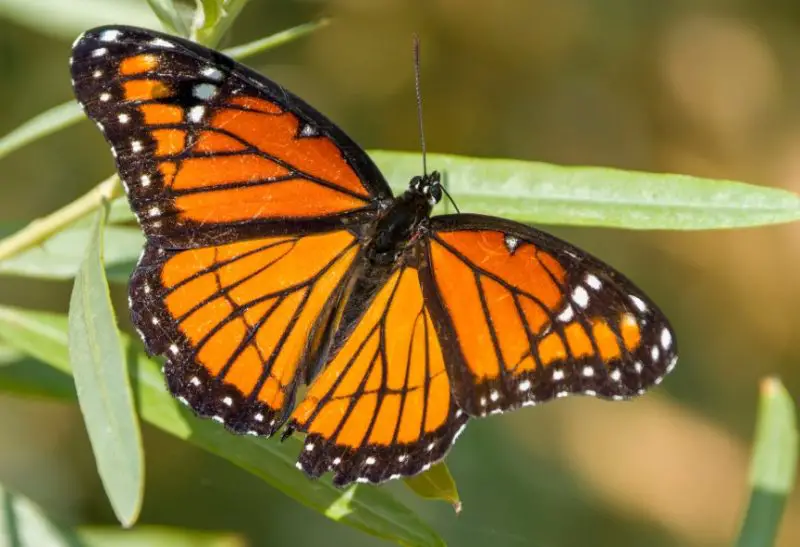
The Viceroy butterfly is best known for its mimicry of the Monarch, sharing similar orange and black coloration, though it is generally smaller, with a wingspan of 2.5 to 3 inches. The most reliable way to distinguish a Viceroy from a Monarch is by the presence of a black horizontal line that crosses the hind wings—a feature absent in Monarchs.
Viceroys are found throughout Florida in moist environments such as marshes, swamps, riverbanks, and lake edges. They are especially prevalent in the central and northern parts of the state but can be found statewide. Adults often rest with wings open and are commonly seen feeding on nectar, rotting fruit, or even animal dung and carrion for minerals.
The larvae of the Viceroy feed on willows (Salix spp.) and poplars (Populus spp.), and they resemble bird droppings as a form of camouflage. The mimicry of Monarchs offers protection from predators, as both species are distasteful due to the chemicals ingested during their larval stage. This clever survival tactic makes the Viceroy a textbook example of Batesian mimicry in nature.
Queen (Danaus gilippus)
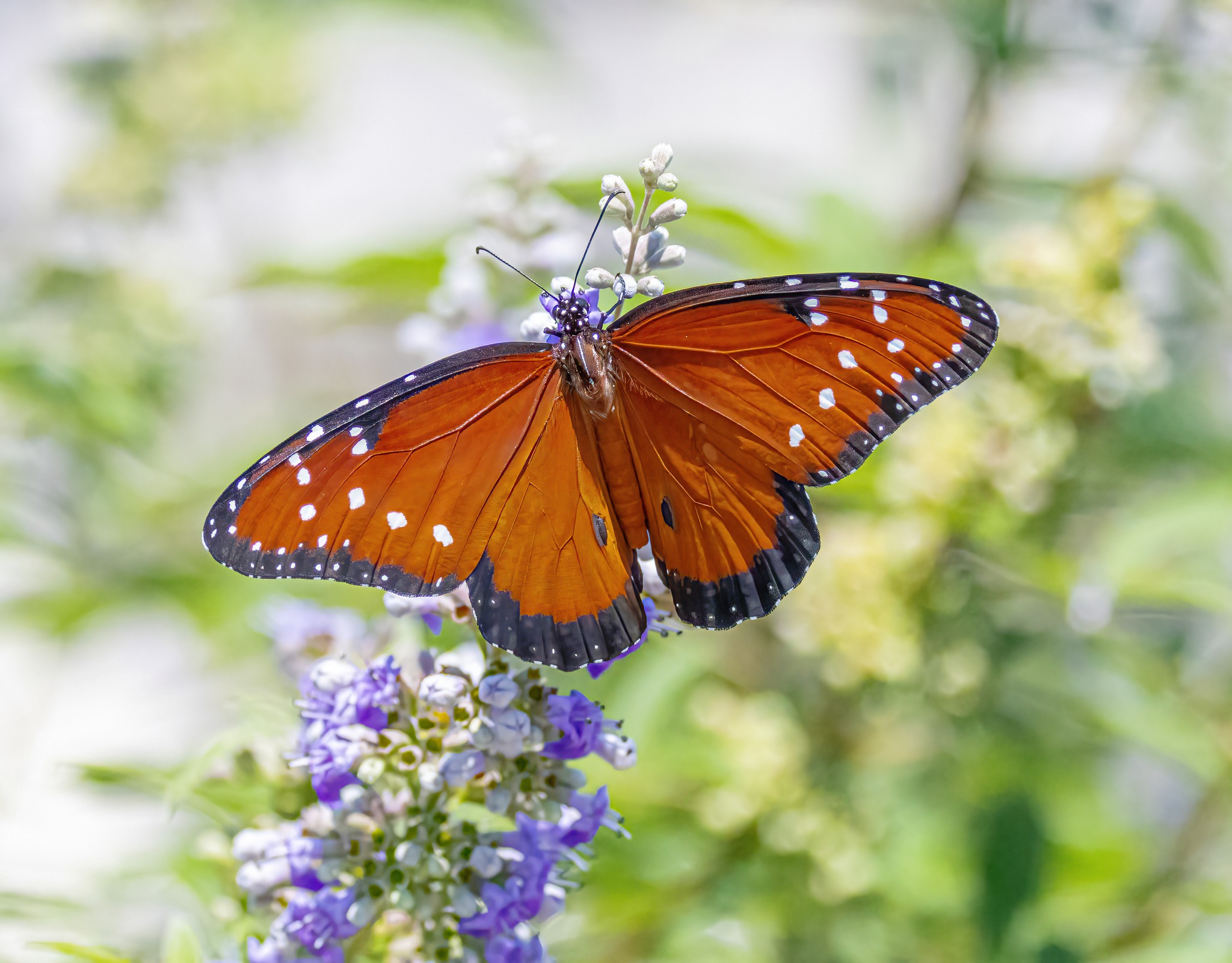
The Queen butterfly is a close relative of the Monarch and shares its elegant wing shape but features a rich chestnut brown coloration with white spots near the forewings’ tips and along the outer margins. Its wingspan typically ranges from 2.6 to 3.1 inches. The hindwings are darker and usually have fewer markings, making the Queen easy to distinguish from its brighter cousin.
This species is found throughout Florida, particularly in the southern regions and the Florida Keys. It thrives in open, sunny habitats such as meadows, gardens, coastal dunes, and disturbed areas where milkweed and nectar plants are plentiful. Like the Monarch, the Queen is non-migratory in Florida and is seen year-round in warm conditions.
Queen butterflies lay eggs on milkweed (Asclepias spp.), which serves as the sole host plant for their caterpillars. The larvae, like those of Monarchs, ingest toxins from the plant that make them unpalatable to predators. Males of this species are known for producing pheromones from specialized scent patches on their hind wings, used to attract females during courtship.
Eastern Tiger Swallowtail (Papilio glaucus)

The Eastern Tiger Swallowtail is one of Florida’s most striking butterflies, known for its bright yellow wings lined with black tiger-like stripes and elegant tails on the hindwings. Females are dimorphic, with one form similar to the male and another form that is almost entirely black, likely a mimic of the poisonous Pipevine Swallowtail. Wingspans can range from 3.1 to 5.5 inches, making them among the largest butterflies in Florida.
This species is commonly found across the state in woodlands, gardens, river valleys, and suburban areas. It is especially abundant in spring and summer, though some individuals can be seen year-round in southern Florida. Adults are strong fliers and are frequently spotted feeding on nectar from a variety of flowers, including azaleas, lilacs, and milkweed.
The caterpillars feed on a variety of host plants, including wild cherry, sweetbay magnolia, and tulip trees. In their final instars, the larvae display large eye-like spots on their thorax, which mimic a snake’s face and help deter predators. Eastern Tiger Swallowtails pupate in a brown or green chrysalis, and their presence often signals a healthy, biodiverse habitat.
Cloudless Sulphur (Phoebis sennae)

The Cloudless Sulphur is a vibrant yellow butterfly that is easy to spot due to its large size and bright lemon-yellow coloration. With a wingspan of 2.2 to 3.1 inches, its unmarked, almost “clean” appearance distinguishes it from other sulphurs. Males are more vividly yellow, while females may be paler or even slightly greenish with small dark markings.
This butterfly is widespread throughout Florida and is particularly active from late spring through fall. It favors open spaces such as roadsides, fields, gardens, and coastal areas. Its strong, fast flight often keeps it high above the ground, though it frequently descends to nectar on red and orange flowers like hibiscus, lantana, and Turk’s cap.
The larvae of the Cloudless Sulphur feed on host plants in the pea family, especially wild senna (Senna spp.). The caterpillars are green with yellow stripes and blend well with foliage. These butterflies are known for their migratory behavior, moving northward in summer and retreating south in fall, with Florida serving as a key year-round breeding ground.
Red Admiral (Vanessa atalanta)

The Red Admiral is a fast-flying and highly adaptable butterfly with velvety black wings marked by bold orange-red bands and white spots near the tips. The striking color pattern makes it easy to identify in flight. Its wingspan is typically around 1.75 to 3 inches. The underside of the wings is mottled brown, offering camouflage when the butterfly is at rest.
In Florida, Red Admirals are common and occur statewide throughout the year. They are most frequently seen in gardens, parks, forest edges, and even urban areas. This species is known for its agility and territorial behavior—males often stake out sunny perches and aggressively chase away intruders.
Red Admiral caterpillars feed on various species of nettles, including Urtica dioica and Boehmeria cylindrica. The adults are highly attracted to fermented fruit and sap, and they also visit flowers for nectar. Their migratory behavior and adaptability make them one of the most widespread butterflies in both temperate and tropical parts of the world.
Buckeye (Junonia coenia)
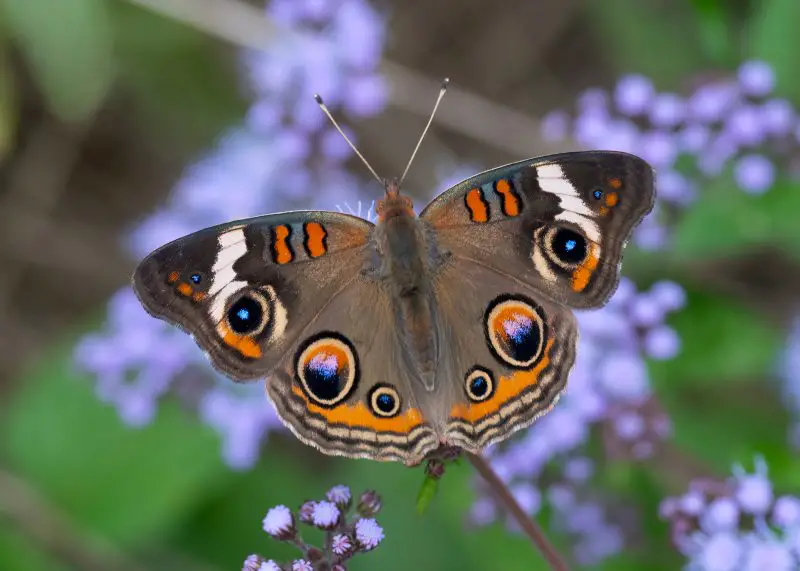
The Buckeye butterfly is a medium-sized species with a wingspan of 1.5 to 2.75 inches, known for its striking eyespots and bold patterning. The forewings are brown with orange bands and two large eyespots, while the hindwings have two additional prominent eyespots that serve to confuse and deter predators. Its appearance is both beautiful and functional in defense.
Buckeyes are commonly seen throughout Florida, especially in open, sunny areas such as pastures, vacant lots, sandy fields, and roadside vegetation. They are present year-round in the southern part of the state and become abundant during warm months in the north. Their flight is low and erratic, often stopping to bask on bare ground or feed from low-growing flowers.
Caterpillars feed on a variety of host plants in the snapdragon and plantain families, including Plantago, Ruellia, and Linaria. The larvae are dark with orange markings and spines. Adult Buckeyes are nectar generalists and can be seen visiting a wide array of wildflowers. Their adaptability and widespread presence make them a favorite among butterfly watchers and photographers alike.
Spicebush Swallowtail (Papilio troilus)
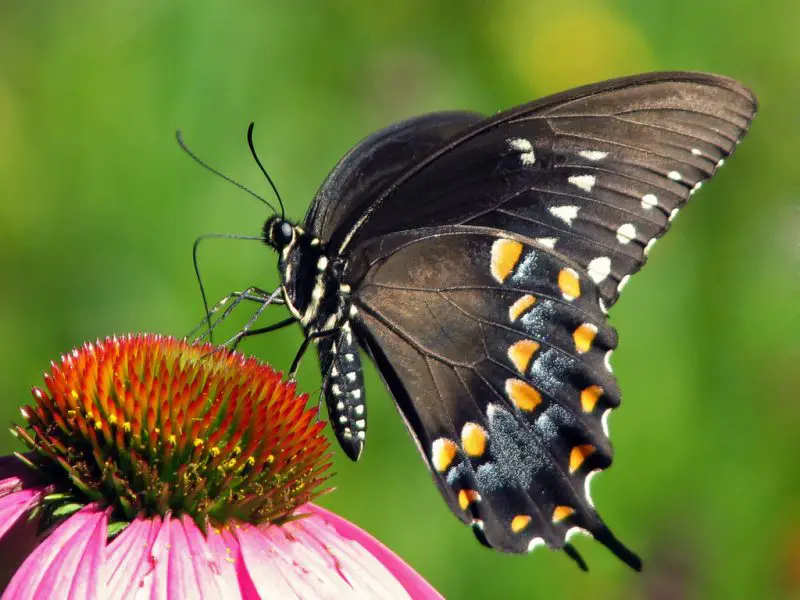
The Spicebush Swallowtail is a dark-winged butterfly with a wingspan of about 3 to 4 inches. Males are mostly black with greenish-blue scaling on the hindwings, while females often display a stronger iridescent blue. A row of light-colored spots outlines the edge of the wings, and the hindwings end in graceful tails. Their mimicry of the poisonous Pipevine Swallowtail helps deter predators.
In Florida, the Spicebush Swallowtail can be found in shaded woodlands, gardens, and hammocks. Though more commonly seen in northern and central parts of the state, it also appears in the south during warm seasons. This butterfly often flutters low to the ground and favors shady paths and forest edges, where its host plants grow.
Its larvae feed on spicebush (Lindera benzoin) and redbay (Persea borbonia), both members of the laurel family. The caterpillars are particularly notable for their comical appearance, with large, false eyespots on their thorax that mimic a snake’s head. This defense mechanism, along with the adult’s mimicry, makes the Spicebush Swallowtail a fascinating example of survival through deception.
Zebra Swallowtail (Eurytides marcellus)
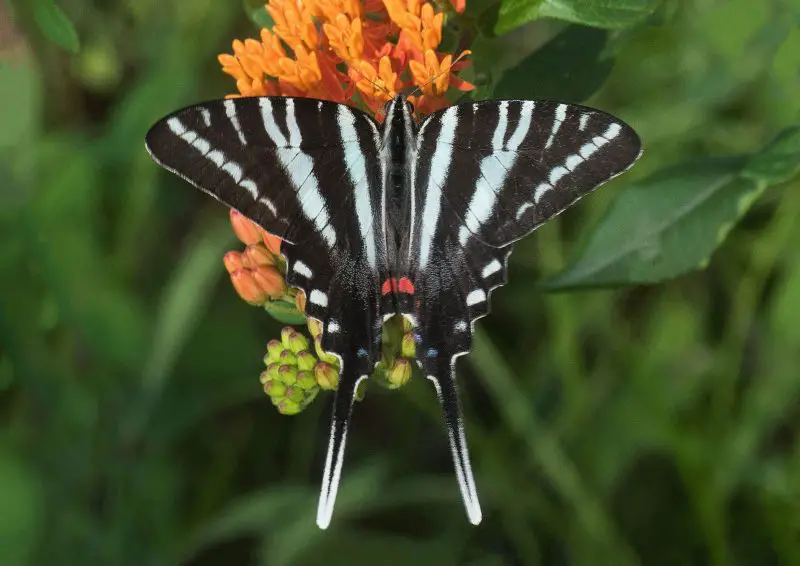
The Zebra Swallowtail is a uniquely elegant butterfly marked by bold black and white zebra-like stripes. It also features long, sword-like tails that make it instantly recognizable. The wingspan ranges from 2.5 to 4.1 inches. In spring broods, the tails are shorter, while summer individuals have longer tails and brighter red markings near the hindwings.
This species is found primarily in northern and central Florida, particularly near moist woodlands and swamps where its host plant, the pawpaw (Asimina spp.), grows. It’s less common in the southern parts of the state due to the host plant’s limited range. Zebra Swallowtails have a slow, floating flight and often glide between perches or flowers.
Caterpillars feed exclusively on pawpaw species, which contain chemical compounds that make them unpalatable to predators. Adult butterflies nectar on a variety of flowers, including milkweed, verbena, and blueberry blossoms. Because of their reliance on a specific host plant, their presence indicates a healthy native ecosystem and is often a delight for butterfly enthusiasts.
Giant Swallowtail (Papilio cresphontes)

The Giant Swallowtail is the largest butterfly in North America, with an impressive wingspan of 4 to 6 inches. It is predominantly black with bold yellow bands across the forewings and a striking yellow and blue pattern on the hindwings. The undersides are lighter and feature a rich mix of yellow and brown. Despite its size, it is a graceful and agile flier.
This butterfly is common throughout Florida and can be seen in gardens, citrus groves, hammocks, and pine flatwoods. It is particularly fond of sunny, open areas and is frequently observed flitting through suburban neighborhoods. Its flight is slow and fluttering, often dipping and gliding in an elegant, looping pattern.
The Giant Swallowtail’s caterpillars are known as “orange dogs” due to their habit of feeding on citrus trees, making them familiar to many Florida gardeners. The larvae resemble bird droppings, which provides excellent camouflage. Although sometimes considered pests in commercial citrus operations, these butterflies play an important role in pollination and are a vital part of Florida’s diverse insect life.
Cassius Blue (Leptotes cassius)
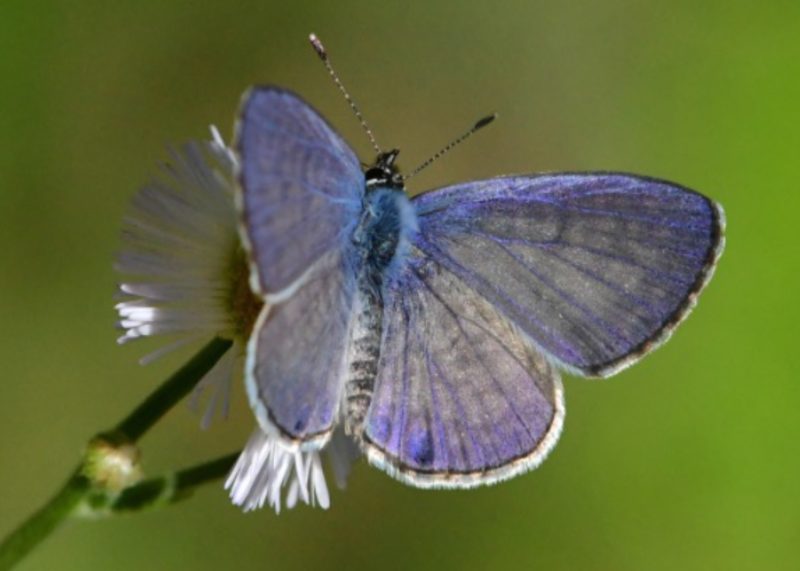
The Cassius Blue is a tiny but charming butterfly with a wingspan of just 0.75 to 1.25 inches. The upper sides of the wings are a pale blue to bluish-gray in males and duller in females, while the undersides display complex white, gray, and brown markings with distinctive eye spots on the hindwings. These patterns help camouflage the butterfly when at rest.
In Florida, this species is especially common along the coasts and in urban gardens, but it can be found statewide. It is particularly abundant in southern Florida and the Keys. Cassius Blues thrive in disturbed areas, coastal scrub, and flower beds, often fluttering low over low-growing vegetation and shrubs.
Caterpillars feed on a variety of leguminous plants, including leadwort (Plumbago), wild tamarind, and beans. Adults are active year-round in warm regions and can often be seen in large numbers around flowering plants. Their small size and fast, jerky flight make them a lively presence in Florida’s butterfly gardens.
Atala (Eumaeus atala)
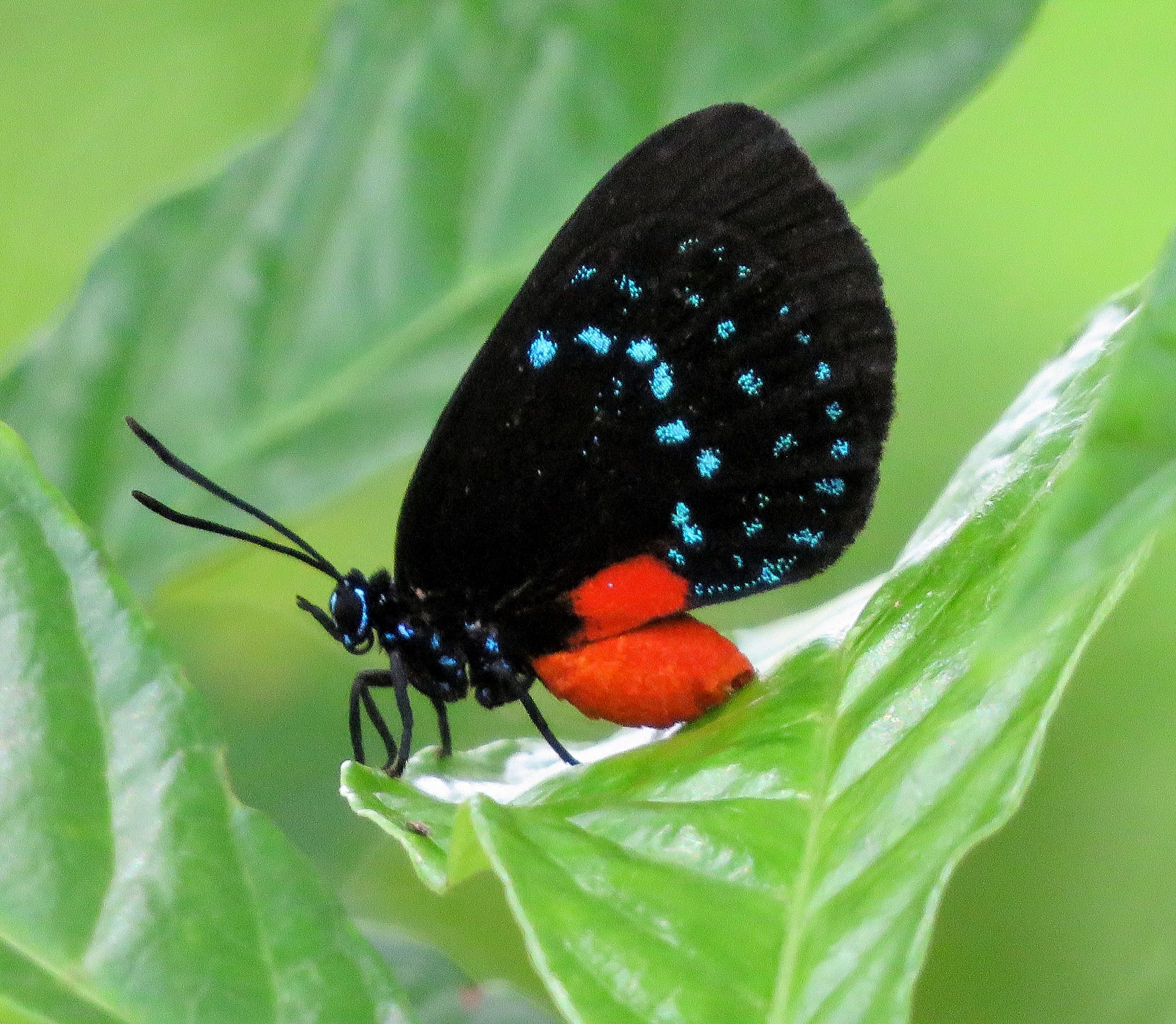
The Atala butterfly is a small, striking species known for its iridescent blue-black wings and vibrant red-orange abdomen. The hindwings are decorated with metallic blue spots, making it one of Florida’s most visually stunning butterflies. With a wingspan of about 1.5 to 2 inches, it compensates for its size with vivid, unmistakable coloration.
Once thought to be extinct in Florida due to habitat loss, the Atala has made a dramatic comeback thanks to the widespread planting of its host plant, coontie (Zamia integrifolia), a native cycad. It is now common in southeastern Florida, especially in landscaping and restoration projects that feature native plants. These butterflies are often seen fluttering slowly among ornamental plantings in parks and neighborhoods.
The Atala’s caterpillars are bright red with yellow spots and feed exclusively on coontie, which contains toxic compounds. These toxins are stored in the larval and adult stages, providing chemical defense against predators. The Atala’s revival highlights the importance of native plant conservation and serves as an inspiring story of urban wildlife resilience.
Gray Hairstreak (Strymon melinus)
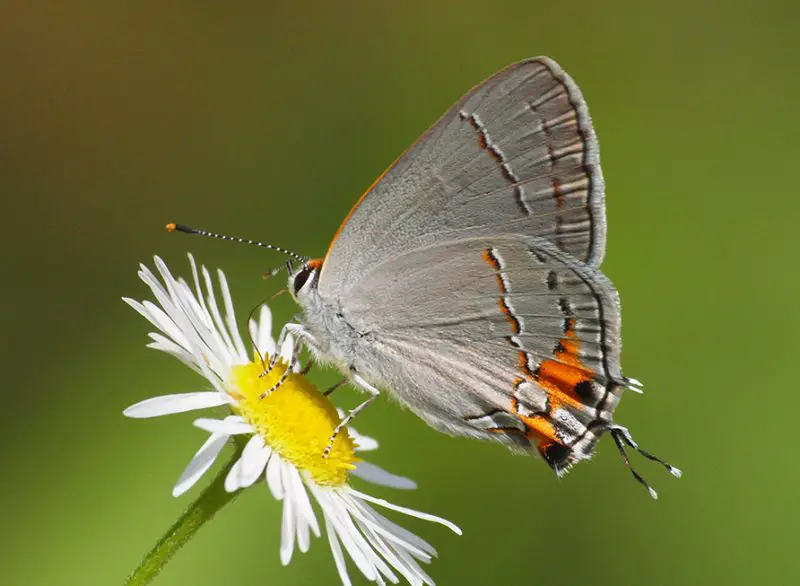
The Gray Hairstreak is a small, sleek butterfly characterized by its smooth gray wings and slender tails on the hindwings. It features a distinct orange spot near the tail and fine black and white lines across the wings. The undersides are a lighter gray with similar markings. Its delicate tail and eyespot pattern help distract predators, often tricking them into attacking the tail end instead of the head.
This butterfly is widespread and adaptable, found throughout Florida in both urban and natural settings. It frequents gardens, roadsides, meadows, and scrubby habitats, often seen perching on low vegetation or feeding on flower nectar. Despite its subtle coloration, it is one of the most common hairstreaks in the state and can be observed year-round in the warmer southern regions.
The Gray Hairstreak is a generalist when it comes to host plants, using a wide variety of legumes and mallows for its larvae. Adults are agile and active, frequently visiting milkweed, clover, and other nectar sources. Its widespread range and ability to adapt to disturbed environments make it one of Florida’s most resilient butterfly species.
Little Yellow (Eurema lisa)
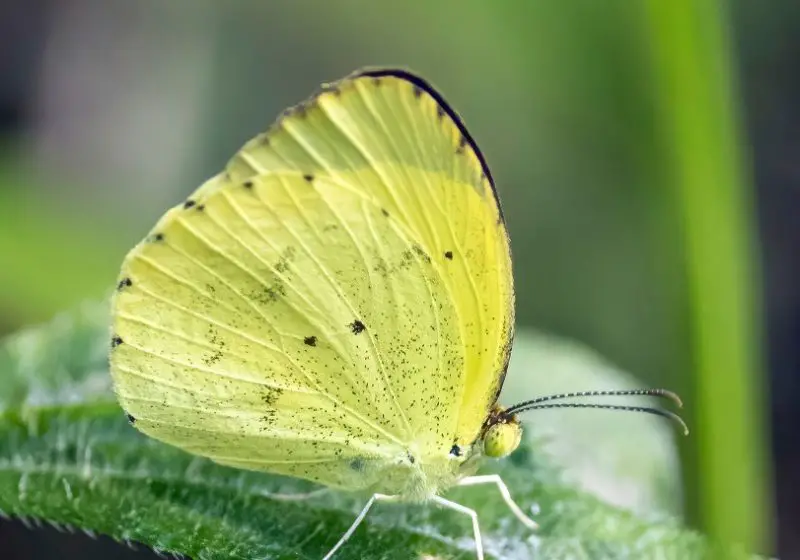
The Little Yellow is a small butterfly with bright yellow wings edged in black, particularly on the forewings. It has a wingspan of around 1 to 1.5 inches and is one of the smallest butterflies in Florida. The underside of the wings is paler, sometimes with faint spots, providing camouflage while resting among grasses and low vegetation.
This species is abundant in open, sunny areas such as fields, roadsides, meadows, and coastal dunes throughout Florida. It is especially noticeable during the warmer months, when populations peak, and it can often be seen fluttering close to the ground in a zigzag flight pattern. It is a frequent sight in wildflower-rich habitats.
The caterpillars of the Little Yellow feed on partridge pea (Chamaecrista fasciculata) and related plants, which are common in Florida’s open habitats. Adults are active from spring through fall and sometimes year-round in southern parts of the state. Despite its tiny size, the Little Yellow plays an important role in pollination and is a cheerful presence in Florida’s butterfly communities.
Great Southern White (Ascia monuste)

The Great Southern White is a medium-sized butterfly with white wings bordered in charcoal gray or black and a distinctive pale blue or turquoise head and eyes. Its wingspan ranges from 2 to 2.75 inches. The blue-tipped antennae are also a notable identifying feature, especially visible during close observation.
This species is commonly found along Florida’s coasts, particularly in salt marshes, dunes, and open grassy fields. It thrives in warm, humid environments and is often seen fluttering in groups near the shore. Though more concentrated in southern and coastal Florida, it may appear inland during warmer months or in open, sunny areas.
The host plants for the Great Southern White include various members of the mustard family, such as wild radish and sea rocket. The caterpillars are green and striped, blending in well with their host plants. This butterfly’s graceful flight and bright white wings make it a familiar sight in coastal Florida, contributing to the region’s biodiversity.
Phaon Crescent (Phyciodes phaon)

The Phaon Crescent is a small, intricately patterned butterfly with orange and black wings adorned with creamy yellow and white bands. Its wingspan ranges from 1 to 1.5 inches. Though similar to the Pearl Crescent, it can be distinguished by the unique yellow median band on the forewings and the checkered pattern on the hindwings.
In Florida, this butterfly is found throughout the state in sunny, moist environments such as roadsides, lawns, parks, and the edges of wetlands. It is particularly common in the spring and summer but can be seen year-round in the southern part of the state. The Phaon Crescent is an active flyer and often feeds close to the ground on a variety of flowers.
Its primary host plant is the common frogfruit (Phyla nodiflora), a low-growing native plant often found in lawns and wetlands. The availability of this plant helps support healthy populations of Phaon Crescents. Its presence indicates healthy wetland-edge ecosystems and well-maintained grassy habitats in suburban and natural areas alike.
Dainty Sulphur (Nathalis iole)

The Dainty Sulphur is North America’s smallest butterfly, with a wingspan of just 0.75 to 1.25 inches. It has soft yellow wings with black edging and a few small black spots, and females may be slightly more heavily marked than males. The underwings are paler and help camouflage the butterfly in its low, grassy habitat.
This tiny butterfly is widely distributed in Florida, favoring open spaces like fields, pastures, and roadside vegetation. It is especially prevalent in southern and central Florida, where it can be active nearly year-round. Its low, erratic flight often keeps it close to the ground, and it’s usually seen singly or in small numbers.
Dainty Sulphur caterpillars feed on plants in the aster family, particularly low-growing species like dogweed (Dyssodia spp.). Despite its small size, it is a tough and resourceful species capable of surviving in disturbed areas and recovering quickly after storms or environmental stress. Its resilience and cheerful presence add charm to Florida’s butterfly fauna.
Julia Heliconian (Dryas iulia)
![]()
The Julia Heliconian is a striking butterfly recognized by its long, narrow wings and vibrant orange coloration. Its wings are bright orange on the upper side with subtle black borders, while the undersides are duller brownish-orange for camouflage. With a wingspan of about 3.5 to 4 inches, it is one of the more slender butterflies in Florida.
This butterfly is most commonly found in South Florida, especially in tropical and subtropical environments such as gardens, hammocks, and forest edges. It thrives in warm, humid climates and is often spotted in butterfly gardens where passionflower vines—the host plants for its larvae—are cultivated. In the wild, it can be seen gliding gracefully, often with a slow and elegant flight pattern.
Julia Heliconians feed on nectar from lantana, shepherd’s needle, and other flowering plants. The caterpillars are spiny and feed primarily on Passiflora species. Adults are long-lived compared to many other butterflies and are known for their territorial behavior, especially males that patrol garden edges and sunny clearings. Its elegance and vivid color make it a favorite among butterfly enthusiasts in South Florida.
Tropical Checkered-Skipper (Pyrgus oileus)
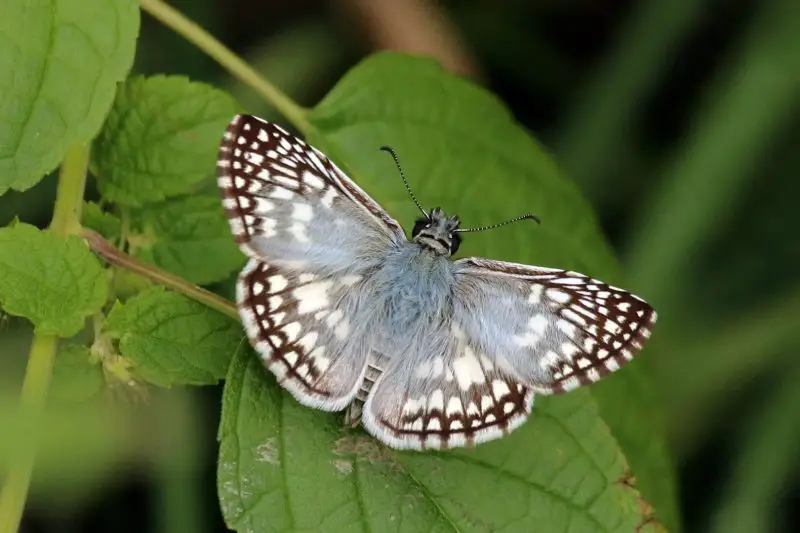
The Tropical Checkered-Skipper is a small, quick-flying butterfly with distinctive checkered patterns on its wings. The upper side of the wings displays a checkerboard of white and dark brown, while the body is covered in bluish-gray scales. With a wingspan of about 1 to 1.5 inches, it is one of Florida’s more common skippers.
This species is prevalent in South Florida but can also be found throughout much of the state in open, sunny habitats. It frequents gardens, pastures, roadsides, and disturbed fields. It often rests with its wings spread flat, which makes its unique wing pattern easy to observe.
The larvae feed on various mallows, especially Malva and Sida species, which grow readily in weedy or disturbed areas. Adults are fond of low-growing flowers such as shepherd’s needle and Spanish needles. The Tropical Checkered-Skipper is active year-round in Florida and can be seen darting quickly from flower to flower or basking in the sun on low foliage.
Southern Dogface (Zerene cesonia)

The Southern Dogface gets its name from the curious dog-head-shaped pattern formed by the black and yellow markings on its forewings. It is a medium-sized butterfly, with a wingspan of about 2 to 2.75 inches. The upper wings are bright lemon-yellow bordered in black, while the undersides are pale yellow with subtle markings.
This butterfly is found in open areas such as fields, roadsides, pine flatwoods, and savannas across Florida, though it is more commonly encountered in the northern and central regions. It has a swift, erratic flight and is usually seen on warm, sunny days. Though less abundant than some other sulphurs, it is a distinctive and eye-catching species.
Southern Dogface caterpillars feed on various legumes, including false indigo and clover species. Adults are frequently attracted to flowers like butterfly bush and wild morning glories. Its unusual wing pattern and preference for open, sunny spaces make it a memorable species in Florida’s butterfly landscape.
Red-spotted Purple (Limenitis arthemis astyanax)
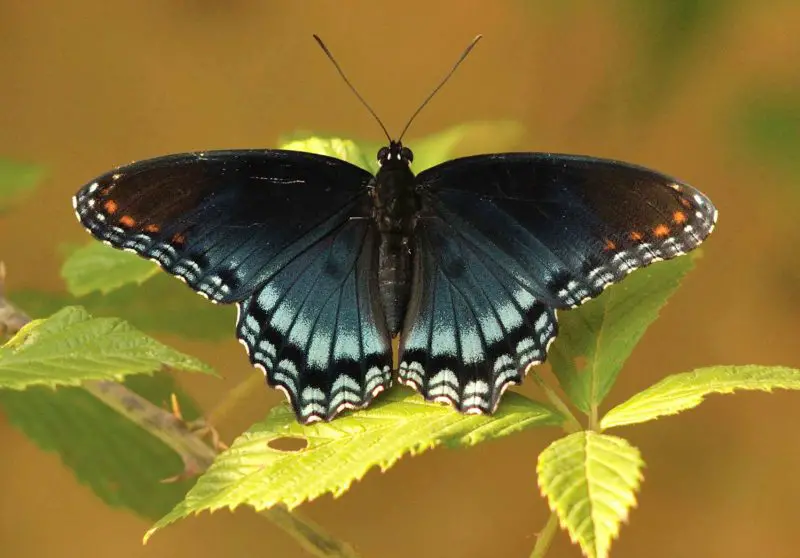
The Red-spotted Purple is a stunning butterfly with iridescent blue and black wings and subtle reddish-orange spots near the edges. Despite the name, the red spots are relatively small, but the shimmering blue overlay on the hindwings gives it a regal appearance. It has a wingspan of about 3 to 4 inches and is often confused with pipevine swallowtails due to mimicry.
This butterfly is widely distributed across Florida and prefers wooded habitats, shaded trails, and forest edges. It is particularly common in hardwood hammocks and along streams. The Red-spotted Purple rarely visits flowers, preferring tree sap, rotting fruit, or moist ground where it can drink nutrients.
The larvae resemble bird droppings in both shape and color—a clever form of camouflage—and feed on a variety of trees, including cherry, willow, and poplar. Adults are solitary and have a graceful, gliding flight. Its mimicry of toxic butterflies helps protect it from predators, and its presence often indicates a healthy woodland ecosystem.
Malachite (Siproeta stelenes)

The Malachite butterfly is one of the most striking species in Florida, known for its vivid lime-green and black pattern. The upper sides of the wings are bright green with thick black borders and veins, while the undersides are a muted brown and pale green. With a wingspan of 3 to 4 inches, it is a large and visually impressive butterfly.
Malachites are typically found in tropical and subtropical parts of South Florida, especially in hardwood hammocks, tropical gardens, and shady forest edges. Though not as widespread as other species, they can be quite abundant in the right conditions and are especially common in the Miami-Dade region and the Keys.
The larvae feed on members of the Acanthaceae family, especially Ruellia and Blechum. Adults prefer rotting fruit and tree sap over flower nectar and are often seen feeding on overripe bananas or mangos in butterfly gardens. With its dazzling coloration and tropical flair, the Malachite is a jewel of Florida’s southern butterfly fauna.
American Painted Lady (Vanessa virginiensis)

The American Painted Lady is a medium-sized butterfly known for the two large eye spots on the underside of its hindwings, which distinguish it from its close relatives. Its upper wings are orange with black and white markings, creating a vibrant and striking appearance. The butterfly has a wingspan of about 1.75 to 2.5 inches, making it easy to spot in sunny habitats.
This species is widely distributed across Florida and can be found in meadows, gardens, roadsides, and open woodlands. It is particularly fond of sunny areas with abundant flowering plants. In Florida’s warm climate, it can be observed throughout the year, with peak numbers appearing in spring and fall during migration and breeding periods.
The larvae of the American Painted Lady feed primarily on plants from the Aster family, especially cudweed (Gnaphalium), which is common in Florida. Adults enjoy nectar from a variety of blooms, including thistles and goldenrods. Their rapid and erratic flight, combined with their colorful patterns, makes them a delight for butterfly watchers and gardeners alike.
Question Mark (Polygonia interrogationis)

The Question Mark butterfly is easily recognized by the small silver “question mark” shape on the underside of its hindwings. The upper side is orange with black spots, and the hindwings are edged in dark brown. This species has a wingspan of about 2.25 to 3 inches and is known for its angular, leaf-like wing shape.
In Florida, the Question Mark is found in wooded areas, suburban gardens, and parks. It prefers areas with plenty of shade and nearby trees, especially elms and hackberries, which serve as host plants for its caterpillars. The butterfly is seen year-round in Florida, but is more abundant during the cooler months when other species are less active.
Unlike many butterflies, the Question Mark often feeds on tree sap, rotting fruit, and even animal droppings more than flower nectar. It is known for basking in sunny clearings and often flies in a slow, gliding manner when disturbed. The camouflage provided by its underside helps it blend into dead leaves when at rest.
White M Hairstreak (Parrhasius m-album)
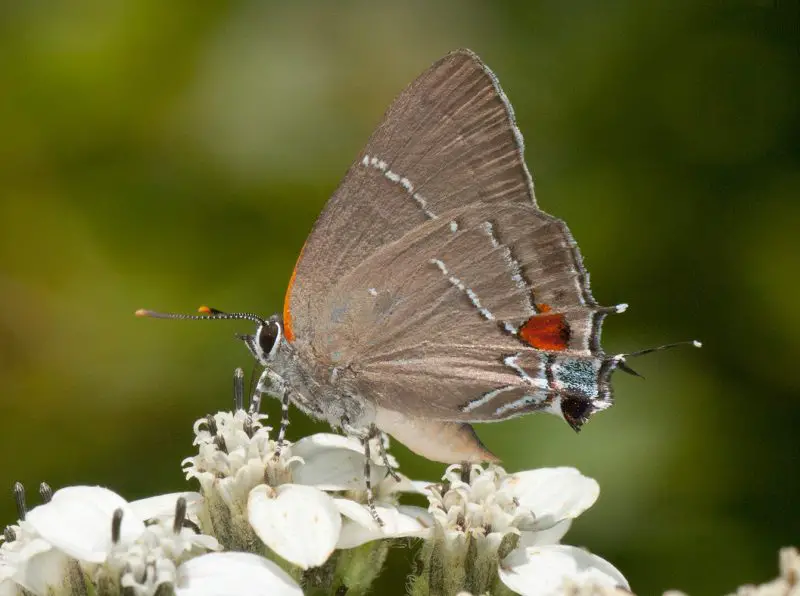
The White M Hairstreak is a small butterfly noted for the delicate white “M”-shaped marking on the underside of its hindwings. The upper side is a brilliant iridescent blue, especially visible in males, while the undersides are gray with subtle black and orange markings. Its wingspan typically ranges from 1 to 1.25 inches.
This hairstreak is found across Florida in a variety of habitats, including oak woodlands, gardens, and suburban areas. It is most often associated with live oak trees, where its larvae feed on the leaves. The butterfly is present year-round in Florida’s warm climate, though it may be more commonly seen from spring through fall.
Adults feed on nectar from flowers such as dogbane, milkweed, and wild plum. They often perch with wings closed, showing only the undersides, which helps them avoid predators. With its metallic flash and characteristic wing shape, the White M Hairstreak is a subtle but beautiful member of Florida’s butterfly community.
Red-banded Hairstreak (Calycopis cecrops)

The Red-banded Hairstreak is a tiny yet elegant butterfly recognized by the vivid red or orange band running diagonally across its gray hindwings. It also features small blue spots near the tail-like projections on the wings, which act as false antennae to distract predators. The upper side is a uniform grayish brown, often unseen during rest.
In Florida, this hairstreak is widespread and common in scrublands, pine flatwoods, gardens, and roadsides. It is especially drawn to leaf litter and low vegetation. Unlike many butterflies, its larvae feed not on live plants, but on decaying leaf matter—especially fallen wax myrtle and sumac leaves.
Adults prefer nectar from small flowers close to the ground such as shepherd’s needle and Spanish needles. With a wingspan of only 0.75 to 1.25 inches, the Red-banded Hairstreak is easily overlooked, but its striking coloration and tail-wagging behavior make it fascinating to observe once spotted.
Barred Yellow (Eurema daira)
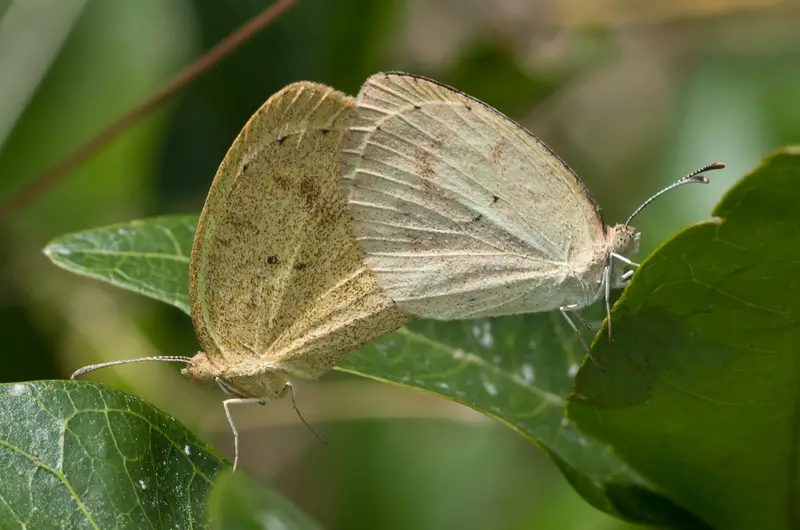
The Barred Yellow is a small, lemon-yellow butterfly that features a distinct brown or black bar across the forewings, which gives the species its name. The wings are bright yellow on top, and the underside is paler with subtle patterning. Its wingspan ranges from 1.25 to 1.75 inches, making it a dainty but noticeable flier.
This butterfly is found throughout Florida, especially in open fields, coastal scrub, pastures, and roadsides. It prefers sunny, disturbed areas where its host plants—members of the pea family like Cassia—are common. It is active year-round in the state due to Florida’s mild winters.
Barred Yellows are fast and erratic flyers, often fluttering low to the ground. They nectar on small flowers and are frequently seen in groups near puddles or moist soil, a behavior known as puddling. Though small, their bright coloration and energetic behavior make them an important part of Florida’s butterfly biodiversity.
Palamedes Swallowtail (Papilio palamedes)
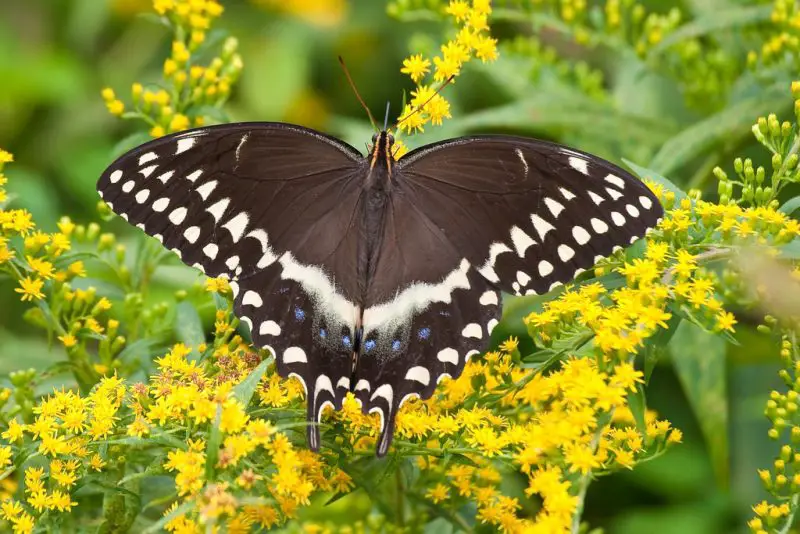
The Palamedes Swallowtail is a striking black swallowtail butterfly characterized by bright yellow spots and bands on its wings. Its wingspan typically ranges from 3 to 4 inches, making it a medium to large-sized butterfly. The yellow markings contrast sharply with the dark background, giving it a bold appearance.
In Florida, this butterfly is most commonly found in swampy hardwood forests and along streams, where its primary larval host plants—various species of bay trees—are abundant. It is usually active during warm months but can be seen year-round in southern parts of the state due to the mild climate.
Adult Palamedes Swallowtails feed on nectar from a variety of flowers, including azaleas, redbuds, and lantanas. Their flight is strong and graceful, and they often patrol along forest edges and shaded pathways. This species plays an important role in Florida’s ecosystems as a pollinator and indicator of healthy wetland habitats.
Long-tailed Skipper (Urbanus proteus)
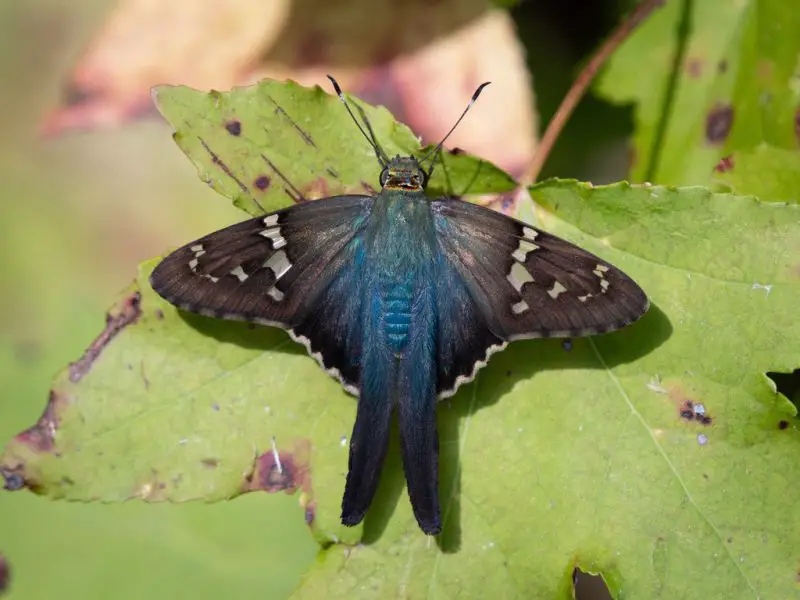
The Long-tailed Skipper is easily identified by its distinctively long tail extensions on the hindwings, along with a sleek, iridescent greenish-blue body. The wings are a rich brown with a subtle sheen, and the butterfly’s fast, erratic flight makes it a lively sight in Florida’s gardens and fields. Its wingspan measures around 2 inches.
This skipper thrives in a variety of open habitats throughout Florida, including gardens, pastures, and disturbed areas. Its caterpillars primarily feed on legumes such as beans and peas, which makes this species common in agricultural and suburban landscapes.
Adults nectar on flowers like lantanas, shepherd’s needle, and bougainvillea. They are known for their rapid movements and ability to dart quickly between flowers, often seeming almost restless. The Long-tailed Skipper’s striking tail filaments and brilliant colors make it a favorite among butterfly enthusiasts.
Silver-spotted Skipper (Epargyreus clarus)
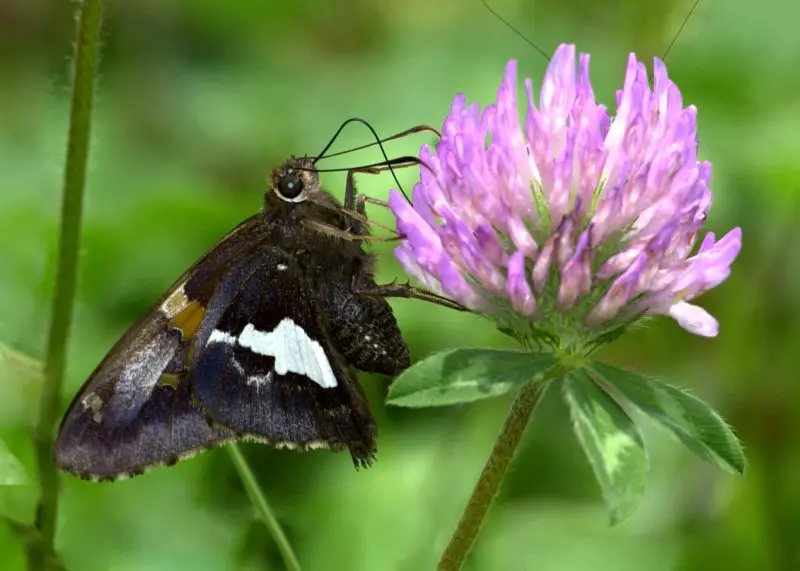
The Silver-spotted Skipper is a large and robust brown butterfly distinguished by a prominent silver patch on the underside of each hindwing. Its forewings are dark brown with orange markings, and the wingspan ranges between 2.25 and 3.5 inches, making it one of the largest skippers in Florida.
Found throughout Florida in open woodlands, gardens, and suburban areas, this butterfly favors sunny spots with abundant nectar plants. Its larvae feed on various leguminous plants, including wisteria, locust trees, and black locust.
Adults feed on nectar from flowers such as red clover, milkweed, and dogbane. The Silver-spotted Skipper exhibits a fast, direct flight and often perches with its wings partially open. Its distinctive silver spot helps with camouflage when resting on leaves, blending with sun-dappled foliage.
Dorantes Longtail (Cecropterus dorantes)

The Dorantes Longtail is a small to medium-sized butterfly noted for its long tail on the hindwings and soft lavender or pale purple coloring on the underside of its wings. The upper side is mostly brown with faint markings. It has a wingspan of about 1.5 to 2 inches.
In Florida, this species is usually found in subtropical and tropical habitats such as coastal hammocks, scrublands, and gardens. It is more common in southern parts of the state where the climate supports its preferred host plants, which include various species of beans and legumes.
Adults feed on nectar from a wide variety of flowers, including lantana and shepherd’s needle. Their flight is quick and low to the ground, often seen fluttering close to the leaves of host plants. The Dorantes Longtail is admired for its delicate color and graceful movements.
Great Purple Hairstreak (Atlides halesus)
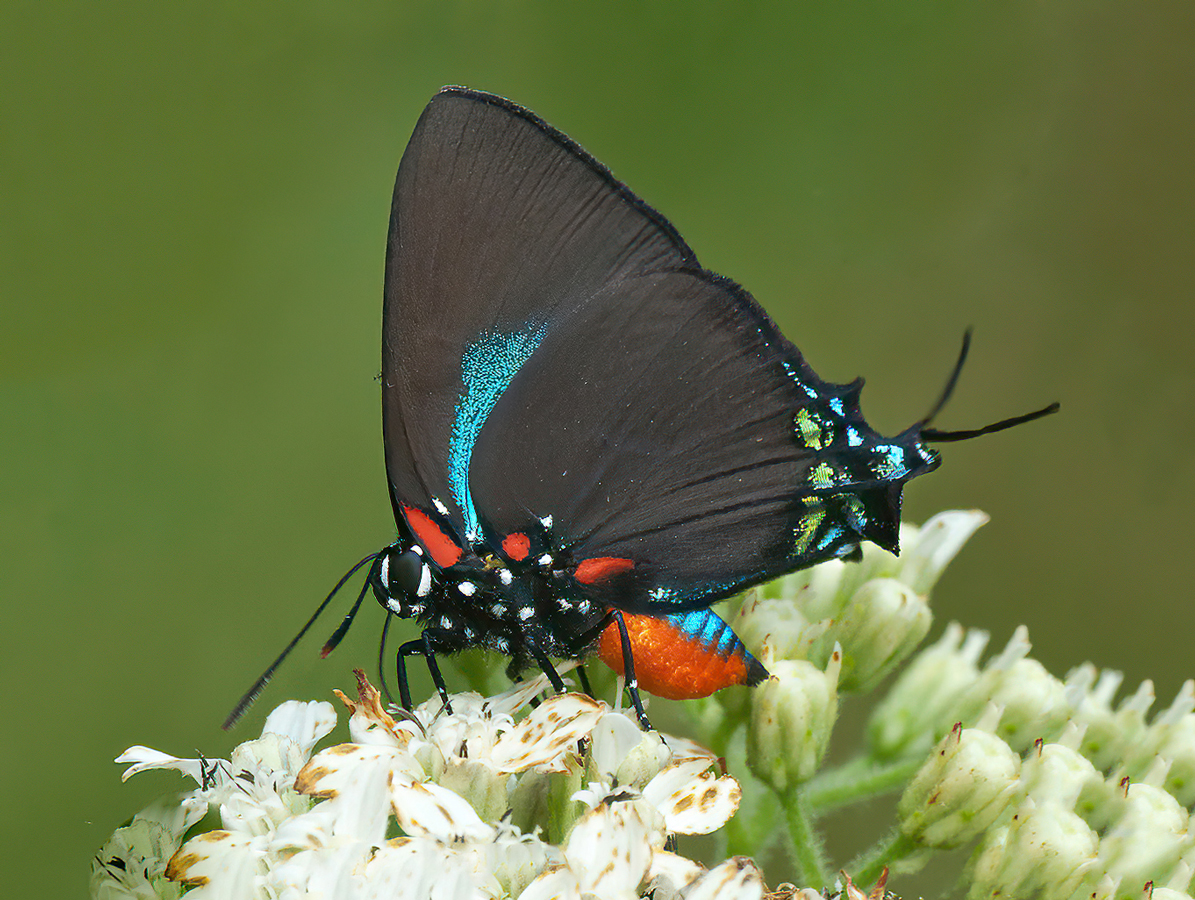
The Great Purple Hairstreak is one of Florida’s most spectacular butterflies, boasting iridescent blue-purple upper wings contrasted with black edges and bright orange spots near the tail. The wingspan typically ranges from 1.75 to 2.5 inches, making it a medium-sized butterfly with vivid coloring.
This species is common in Florida’s pine flatwoods, oak forests, and suburban gardens, especially where mistletoe—a key host plant for its larvae—grows. The butterfly’s larvae feed on the leaves and stems of mistletoe, which contributes to its close association with these plants.
Adults are often seen nectaring on flowers such as dogbane and wildflowers or resting on tree trunks. They are known for their rapid, fluttering flight and tail movements that confuse predators. The Great Purple Hairstreak’s vibrant colors and intriguing behaviors make it a favorite among butterfly watchers in Florida.
Miami Blue (Cyclargus thomasi bethunebakeri)
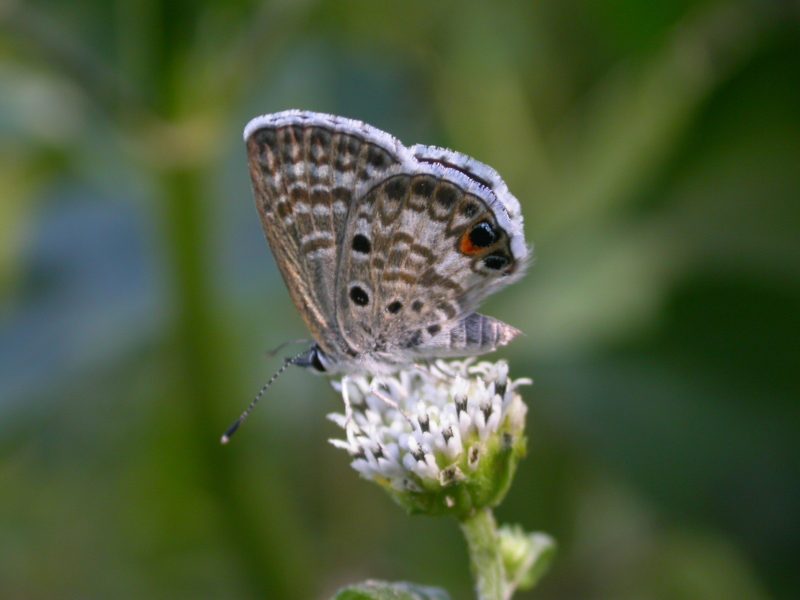
The Miami Blue is a small, delicate butterfly known for its vibrant sky-blue coloration on the upper side of its wings, with grayish undersides marked by faint white spots. It is one of Florida’s rarest butterflies and is considered an endangered species, primarily due to habitat loss and environmental changes. The wingspan of this butterfly is about 1 to 1.25 inches, making it quite small.
This species is endemic to South Florida, especially the coastal areas of the Florida Keys and Miami-Dade County. The Miami Blue prefers coastal scrub and pine rockland habitats, where its larval host plants, such as the blackbead (Pithecellobium keyense), grow. Unfortunately, its limited range and specialized habitat needs make it highly vulnerable.
Behaviorally, the Miami Blue is active and quick, often fluttering close to the ground. Conservation efforts are ongoing to protect this unique butterfly, focusing on habitat preservation and restoration. Its bright blue coloration and rarity make it a treasured symbol of Florida’s natural heritage.
Sleepy Orange (Eurema nicippe)

The Sleepy Orange butterfly is easily identified by its bright orange wings with distinctive black edges on the forewings, creating a bold contrast. The underside is pale yellow to orange with subtle spots, helping it blend into its environment when at rest. This species has a moderate wingspan of about 1.5 to 2 inches.
In Florida, Sleepy Oranges are common in open areas such as fields, roadsides, and gardens. They favor warm climates and are frequently seen fluttering low over flowers and grasses. Their larvae typically feed on various species of legumes, including wild senna.
Adults feed on nectar from flowers like lantana, shepherd’s needle, and tickseed. The Sleepy Orange is known for its rapid, low flight and can be found year-round in South Florida due to the subtropical climate. Its vibrant color and graceful flight make it a familiar and welcome sight.
Checkered White (Pontia protodice)
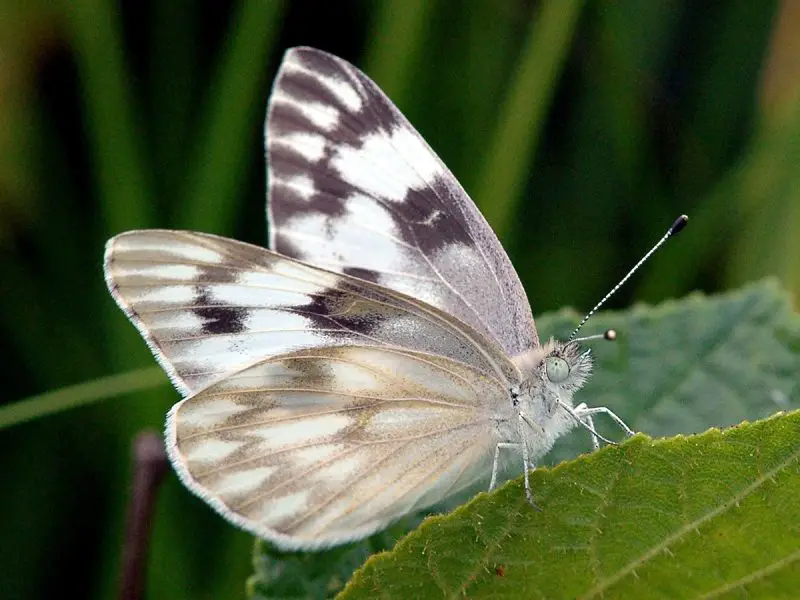
The Checkered White butterfly is named for its distinctive black and white checkered pattern on the undersides of its wings, which resemble a chessboard. The upper side is mostly white with black spots and marks. It has a wingspan ranging from 1.5 to 2 inches.
This species is widespread throughout Florida, especially in sunny open areas such as meadows, fields, and roadsides. Checkered Whites are highly adaptable and can often be seen fluttering near their host plants, which include members of the mustard family like wild radish and cabbage.
Adults feed on nectar from a variety of flowers, including fleabane and aster. They have a quick, fluttery flight and are most active during warm, sunny days. Their distinct checkered pattern makes them easy to identify and a favorite for butterfly watchers.
Little Metalmark (Calephelis virginiensis)
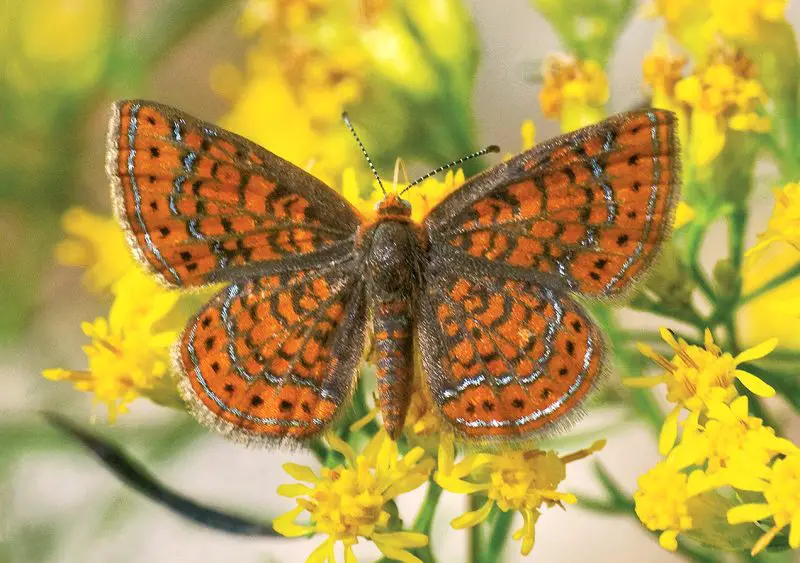
The Little Metalmark is a small butterfly notable for the metallic sheen on the undersides of its wings, which glisten with silvery spots and patches. The upper side is mostly brown with faint orange markings. It is a tiny butterfly, with a wingspan of about 1 inch.
In Florida, the Little Metalmark is typically found in habitats such as open woodlands, scrub areas, and near wetlands. It favors regions where its host plants, usually from the sunflower family, grow. This butterfly’s subtle coloration helps it camouflage well among leaves and bark.
Adults feed on nectar from a variety of small flowers and have a slow, fluttering flight. Their small size and shimmering underwings make them a delightful but sometimes overlooked member of Florida’s butterfly community.
Tawny Emperor (Asterocampa clyton)
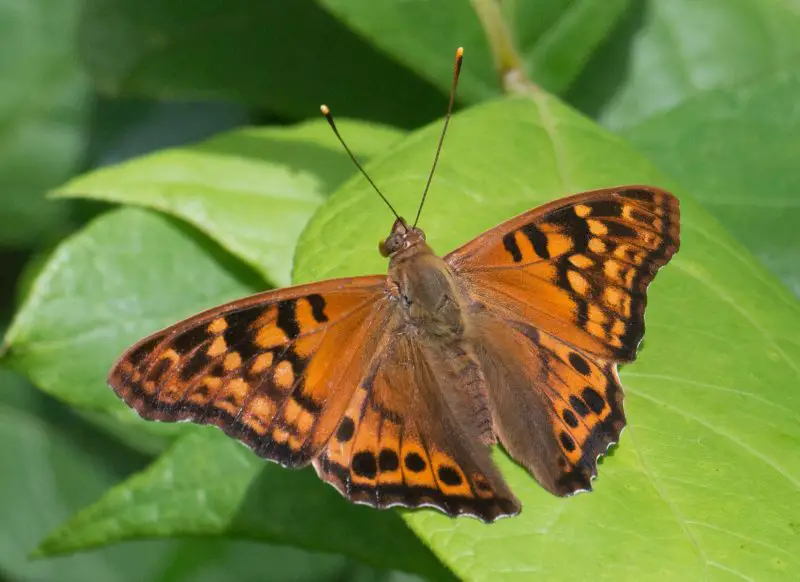
The Tawny Emperor is a medium-sized butterfly characterized by its rich brown wings adorned with intricate orange and cream patterns, giving it a textured appearance. The wingspan typically measures between 2.25 and 3 inches. Unlike many butterflies, Tawny Emperors often prefer tree sap and rotting fruit over flowers for feeding.
This species is widespread in Florida’s woodlands, especially near oak trees, which serve as the main host plants for its caterpillars. Tawny Emperors are most often found in shaded, forested areas rather than open fields or gardens.
Behaviorally, they are known for their strong, fast flight and tend to perch quietly on tree trunks or the ground. Their cryptic coloration helps them blend into the bark, making them less conspicuous to predators. The Tawny Emperor is a fascinating butterfly, notable for its preference for non-floral food sources and woodland habitat.


